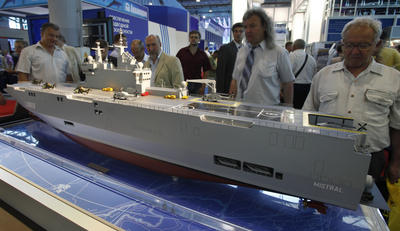This has NATO worried.
Why is Russia interested in the Mistral? In a shrewd move Putin has used the agreement to strengthen relations with France and undermine NATO hostility to Russia, which intensified during the war against Georgia in 2008. With France onside, the anti-Russian feeling that new NATO members in Eastern Europe and the Baltic region have habitually expressed may be checked.
Russia could also modernise and upgrade its defence electronics systems, which have been its weakness since Soviet times. The deal has provoked much concern from Georgia and the Baltic states — Latvia, Lithuania and Estonia — as it would give the Russians a troop-landing capability which could be used against them. The Georgians are particularly perturbed because the vessels could be used to land troops along the Black Sea coast to support the breakaway province of Abkhazia, should a conflict there arise.
The Mistral is an amphibious assault vessel with a fleet command capability. It can land troops ashore in particular conflict zones and, with its electronic equipment, can act as a communications platform to control and coordinate combat operations. France has two such vessels and is building a third for its own navy.
The Mistral class vessel has a deadweight of 21,300 tons, a crew of 160, can transport a maximum of 700 troops and carry up to 16 heavy helicopters. The Russians will probably equip it with the KA-50/52 attack helicopter, the Ka-27K Helix naval helicopter or the Ka-29K utility helicopter. It can also carry 70 armoured vehicles, two hovercraft and four landing craft.
Two Mistrals will be built in French shipyards in St Nazaire, with another two projected to be built later in St Petersburg under another contract. At the outset, the major issue in the negotiations was the accompanying SENIT-9 naval tactical data system and the SIC21 fleet command system, which would significantly enhance Russia’s ability to coordinate combat operations.
Russia has demanded the transfer and licensed production of the electronics employed in the Mistral, but, under pressure from NATO partners, the French have hesitated. The Russians have declared that France will go ahead with the sale of the technology but it is not clear at this stage whether the French will oblige. As opposed to the transfer of the requisite engineering skills, the French may insist on fitting and maintaining these systems themselves, which would slow down but not prevent technology leakage to the Russians.
To alleviate NATO concerns, the Russians have said the Mistral will be deployed in the Asia Pacific, and away from the West. On 9 February this year, an Itar Tass report quoted a Russian defence Ministry ‘informant’, who said that both vessels would be deployed in the Southern Kurile Islands, which Japan claims. Suitable infrastructure, the informant said, would be constructed to accommodate them. Other reports claim that one Mistral vessel will be deployed with the Pacific Fleet at Vladivostok, and another with the Northern Fleet in the Arctic.
Declaring that the Mistrals would be deployed in the southern Kurile Islands appears to be a political ploy to up the ante in escalating polemics with the Japanese over the disputed islands. Since President Dmitry Medvedev visited one of those islands, Kunashir, in November last year, relations with the Japanese have soured.
Medvedev is raising his political profile with the Russians in preparation for the presidential elections next year, and has seized on the dispute with the Japanese to boost his patriotic credentials. He has declared that the islands are an ‘inalienable’ part of Russia, but he has avoided any comment on the Mistral deployment.
Deploying the Mistrals in the Southern Kuriles makes little sense as the islands do not face any military threat from the Japanese and supporting infrastructure would take decades to develop. The idea of consigning them to the remote Arctic is even more senseless. The Pacific Fleet at Vladivostok is a more likely base for them, which would avoid another round of tensions with NATO. The communications and command functions of the Mistrals would significantly enhance the capability of the Pacific Fleet in amphibious and landing operations, but it is difficult to envisage scenarios in which they could be used in the Asia Pacific. Russia’s concerns about China relate to the land border and the vast spaces of the Far East and Siberia, for which a maritime capability is irrelevant, and the Russians have no maritime dispute with the Chinese. Their deployment with the Pacific Fleet at Vladivostok would serve another purpose: they would allow Russia to show the flag not only in the Southern Kurile Islands but in the ASEAN region as well — a step towards the revival of a Russian naval presence in the region.
Leszek Buszynski is Professor of International Relations at the International University of Japan.


The author says “Russia’s concerns about China relate to the land border and the vast spaces of the Far East and Siberia, for which a maritime capability is irrelevant, and the Russians have no maritime dispute with the Chinese.”
I think maritime capacity will help Russia in its conflicts with China, if any, by allowing it to open another front, one which is closer to China’s most affluent regions along the coast.
Mistral is nothing compared to amount of problems Russian military (and not just military) are having at the moment. With the current state of affairs in any branch of Russian forces no Mistral can help with any tactical or strategic power projection. Just Nuclear deterrent saves Russia from being swallowed by China
Mistral would become a sitting duck if the Chinese wanted to dispose of it. Russia’s real problem are millions of Chinese ready and willing to take over major cities on the Russia-China border. This is unavoidable, Chinese 1.3 billion people need space NOW.